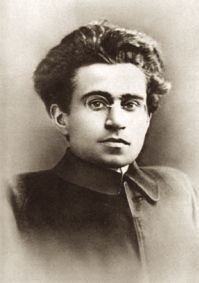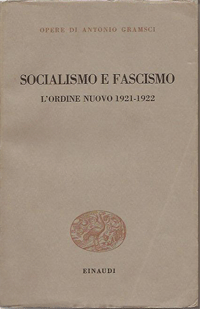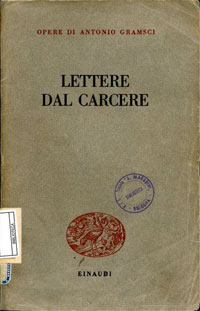



Antonio Gramsci
Ales (Cagliari) 1891 - Roma 1937
Journalist, politician and Italian philosopher, Gramsci studied at the University of Turin under the guidance of the linguist Matteo G. Bartoli. He quit university in favor of political action, and in 1919 founded, together with Palmiro Togliatti, Angelo Tasca and Umberto Terracini, the fortnightly journal «L’Ordine Nuovo». In 1921 he was among the founders of the Italian Communist Party (PCd’I), and from 1922-24 he was a delegate to the executive committee of the Communist International (Moscow, Vienna). Gramsci was elected a member of parliament in April 1924, and in 1926 he became secretary of the PCd’I. He was arrested on 8 November of the same year, and on 4 June 1928 he was sentenced to twenty years of prison. He spent most of his time in the prison of Turi (Bari). At the end of 1933 he was transferred to the Cusumano Clinic in Formia and the, in August 1935, to the Quisisana Clinic of Rome. He died 27 April 1937. After Gramsci’s death (27 April 1937), the papers concerning his period of detention – 1926-1937 (letters, books, journals, as well as 33 notebooks) – were transferred to Moscow and into the care of Palmiro Togliatti on behalf of the Communist Party of Italy. This material was brought back to Rome in April 1950 and deposited in the “Fondazione Antonio Gramsci” which was then being created (from 1954: “Istituto Gramsci”; from 1982: “Fondazione Istituto Gramsci”). The printed material which belonged to the communist leader comprises the first nucleus of the library of the foundation, which has been expanded over time (today it contains more than 135,000 volumes, mainly concentrated on Italian and international history and politics). The Gramsci Library contains 761 volumes, which can be divided as follows: some volumes belonged to Gramsci before his arrest, or were acquired by him after his transfer (always in detention) to the Cusumano Clinic in Formia (December 1933), and therefore never entered the Special Penitentiary in Turi (these books have no prison markings). Others, which contain the circular stamp of the prison in Puglia, were acquired from July 1928 to March 1933 and, based on the signature of the various directors, it is possible to date them with greater precision, subdividing them into three groups: Studies on the library: P. Togliatti, Sui libri che Gramsci lesse in carcere (I° incontro tra Togliatti e Gramsci), «L’Unità» (edizione romana), 19 marzo 1950; G. Carbone, I libri del carcere di Antonio Gramsci, «Movimento operaio», IV, 1952, pp. 3-53; G. Francioni, L’officina gramsciana. Ipotesi sulla struttura dei «Quaderni del carcere», Napoli, Bibliopolis 1984; P. Gabrielli, Il Fondo Gramsci. Una descrizione analitica, «IG Informazioni», IV, 1992, n. 1 (bis), pp. 91-103; D. Di Benedetto, Il fondo Gramsci: un caso di «democrazia telematica», in Gramsci e il Novecento, a cura di G. Vacca in collaborazione con M. Litri, vol. II, Roma, Carocci 1999, pp. 333-339; G. Francioni, Come lavorava Gramsci, in A. Gramsci, Quaderni del carcere. Edizione anastatica dei manoscritti, a cura di G. Francioni, vol. 1, Roma, Istituto dell’Enciclopedia Italiana 2009. To accede to the catalogue of Antonio Gramsci’s library from the site of the Biblioteca della Fondazione Gramsci.
Main works: Tra il 1913 e il 1926, Gramsci pubblicò numerosi articoli su giornali e riviste, ora raccolti dall’editore Einaudi: L’Ordine Nuovo. 1919-1920 (1954); Scritti giovanili. 1914-1918 (1958); Sotto la Mole. 1916-1920 (1960); Socialismo e fascismo. L’Ordine Nuovo. 1921-1922 (1966); La costruzione del Partito comunista. 1923-1926 (1971). Una nuova edizione, corredata di apparati critici, si è fermata al 1920: Cronache torinesi. 1913-1917, a cura di S. Caprioglio (1980); La città futura. 1917-1918, a cura di S. Caprioglio (1982); Il nostro Marx. 1918-1919, a cura di S. Caprioglio (1984); L’Ordine Nuovo. 1919-1920, a cura di V. Gerratana e A.A. Santucci (1987). Dell’epistolario di Gramsci sono state pubblicate dapprima solamente le lettere da lui scritte: Lettere. 1908-1926, a cura di A.A. Santucci, Torino, Einaudi 1992; Lettere dal carcere, a cura di S. Caprioglio e E. Fubini, Torino, Einaudi 1965; Lettere dal carcere, a cura di A.A. Santucci, Palermo, Sellerio 1996, 2 vol. Solo nel 1991 si è avviato il recupero di sezioni dell’epistolario: Piero Sraffa, Lettere a Tania per Gramsci, a cura di V. Gerratana, Roma, Editori Riuniti 1991; Antonio Gramsci-Tatiana Schucht, Lettere 1926-1935, a cura di A. Natoli e C. Daniele, Torino, Einaudi 1997. I manoscritti del carcere sono stati pubblicati in edizione critica nel 1975: A. Gramsci, Quaderni del carcere, edizione critica dell’Istituto Gramsci a cura di V. Gerratana, Einaudi, Torino 1975, 4 vol. È in corso l’Edizione Nazionale degli Scritti.
Bibliography: Bibliografia gramsciana, a cura di J.M. Cammett, F. Giasi e M.L. Righi, http://213.199.9.13/bibliografiagramsci; Bibliografia gramsciana ragionata. 1. 1922-1965, a cura di A. D’Orsi, Roma, Viella 2008; Studi gramsciani. Atti del convegno (Roma, 11-13 gennaio 1958), Roma, Editori Riuniti 1958; Gramsci e la cultura contemporanea. Atti del convegno internazionale di studi gramsciani (Cagliari, 23-27 aprile 1967), 2 vol., a cura di P. Rossi, Roma, Editori Riuniti 1969-1970; L. Paggi, Antonio Gramsci e il moderno principe. I. Nella crisi del socialismo italiano, Roma, Editori Riuniti 1970; Politica e storia in Gramsci. Atti del convegno internazionale di studi gramsciani (Firenze, 9-11 dicembre 1977), a cura di F. Ferri, 2 vol., Roma, Editori Riuniti-Istituto Gramsci 1977-1979; L. Paggi, Le strategie del potere in Gramsci. Tra fascismo e socialismo in un solo paese. 1923-1926, Roma, Editori Riuniti 1984; G. Francioni, L’officina gramsciana. Ipotesi sulla struttura dei «Quaderni dal carcere», Napoli, Bibliopolis 1984; V. Gerratana, Gramsci. Problemi di metodo, Roma, Editori Riuniti 1997; G. Vacca, Gramsci, Antonio, in Dizionario Biografico degli Italiani, vol. 58 (2002); Dizionario gramsciano 1926-1937, a cura di G. Liguori e P. Voza, Roma, Carocci 2009; G. Vacca, Gramsci, Antonio, in Il Contributo italiano alla storia del Pensiero. Filosofia, Roma, Istituto della Enciclopedia Italiana 2012.
Turi I (July 1928-February 1929);
Turi II (March 1929-November 1930);
Turi III (end November 1930-16 March 1933).
As regards the journals and cuttings from journals, the date of acquisition is almost always the publication date.
Some books have the stamp but no director’s signature: in these cases the volumes, although acquired, were probably held by the Penitentiary (as can be seen, for some of them, by a record of request sent to the Prime Minister, contained in Notebook 2, cc. 92v-93v). Some losses which the collection suffered should also be noted. In at least one case (refer to the letter of Ambrogio Donini, then director of the “Fondazione Antonio Gramsci”, to Togliatti, dated 18 November 1952), the removal of “three or four books by Trotski and Bukharin” is noted, removal undertaken in order not to give these authors “useless publicity through this mention” (cf. A. Vittoria, Togliatti e gli intellettuali. Storia dell’Istituto Gramsci negli anni Cinquanta e Sessanta, Editori Riuniti, Roma 1992, p. 189). Useful information about the flow of books in and out of the Penitentiary of Turi is given not only by the Penitentiary stamp, but also in the lists of books sent out of the prison. These lists appear, with a date, in the residual spaces of some notebooks.